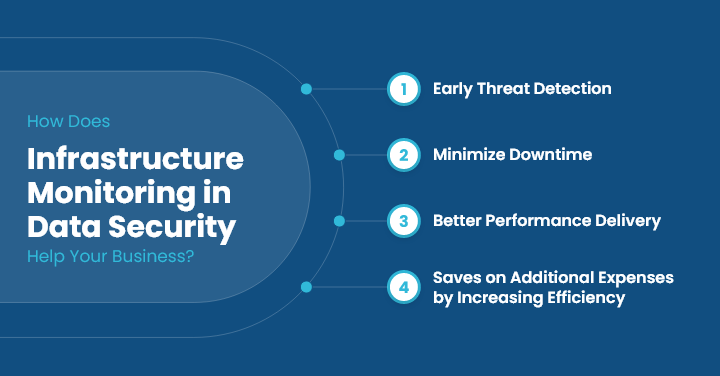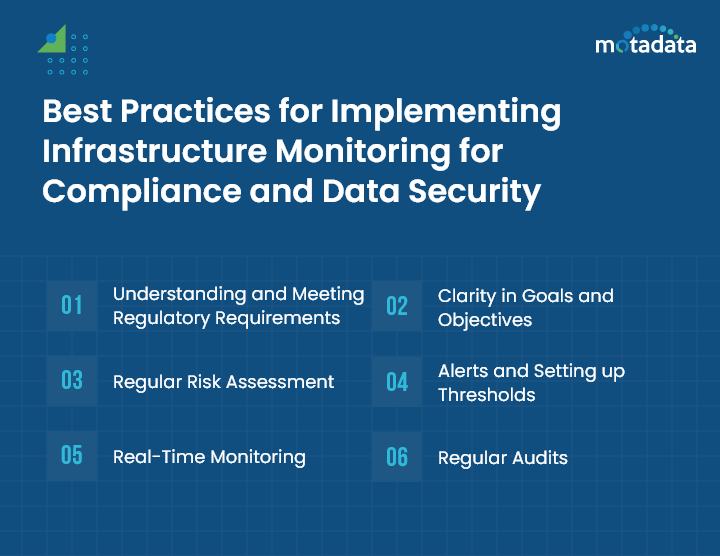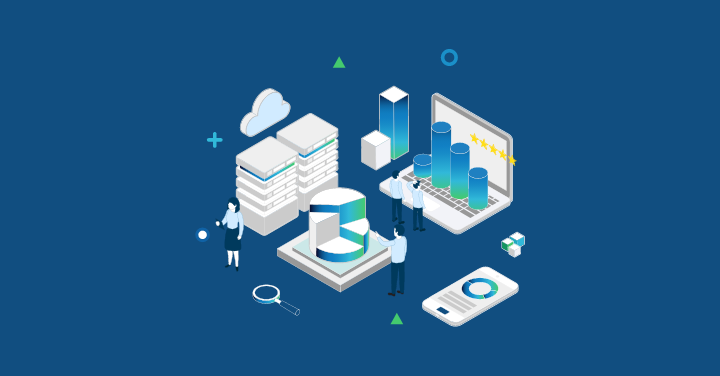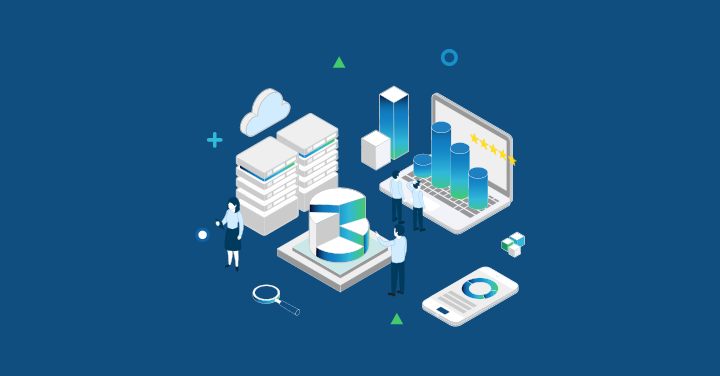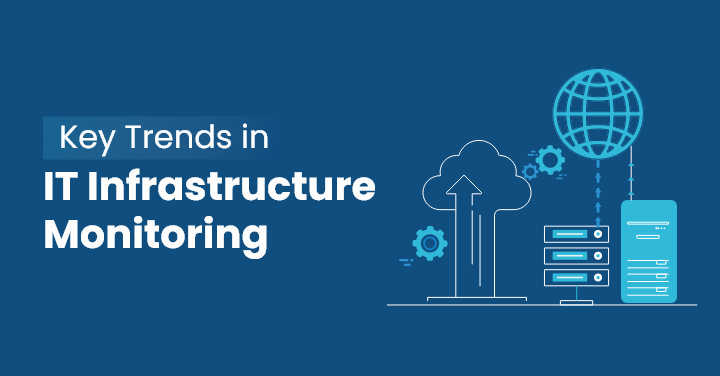In today’s business landscape, where everything is connected through computers and networks, the Role of Infrastructure Monitoring has become paramount.
If we go through the previous year’s reports, around 76% of organizations became victims of ransomware attacks in 2022.
It was also predicted that the year 2023 might experience a security breach of 33 billion accounts.
The cybercrime rate has been increasing over the years, and relying on a basic monitoring strategy won’t be enough to protect your business.
It has become essential for businesses to take proactive measures for their business security and ensure data compliance.
With the right infrastructure monitoring tools in hand, businesses can quickly detect, diagnose, and troubleshoot performance issues before they create any negative impact on end users.
But before we proceed, let us learn more about the role of infrastructure monitoring and how it can help maintain compliance and secure system data.
What is Infrastructure Monitoring?
Infrastructure Monitoring is a process that allows system administrators to collect data from the entire IT infrastructure, monitor it, and analyze it to improve their business outcomes.
The data collected from different network resources, systems, processes, and infrastructure components provides clear visibility into the resource utilization, availability, efficiency, and performance metrics of each application and service.
Today, businesses are more dependent on their applications to generate revenue and so monitoring the performance of each system and application is highly crucial for businesses.
Infrastructure monitoring software helps achieve that goal by detecting and responding to issues proactively and saving good cost, time, and effort.
It even comes with automated alert options that notify administrators of outages and abnormalities in real-time, ensuring they take corrective measures before it impacts user experience.
By implementing the role of infrastructure monitoring, businesses will not only be able to address issues in real-time but make smart decisions and minimize downtime.
Importance of Compliance and Data Security
Businesses communicate and interact with customers and partners on a daily basis and exchange a lot of crucial data across different channels.
The data collected from different sources is a valuable asset for any business as it helps understand and improve business processes.
Now what if due to any negligence or third-party attack you lose your data? Well! In that case, you might undergo huge financial loss as well as lose customer trust.
Hence, data security is crucial for every business, be it small or large.
Similarly, you can’t overstate the significance of compliance as it enables organizations to adhere to the industry regulations and standards and if a business fails to meet the needs, they may face legal penalties and reputational damage.
Hence, compliance and data security both play an important role in business success.
With Infrastructure monitoring software, you can help prevent data breaches and compliance violations by detecting issues proactively.
The infrastructure monitoring tool collects data from different sources, identifies trends and patterns, and detects abnormalities and errors in real time, including during processes like Postgres to Snowflake migrations.
It even sends real-time alerts to the IT staff so that they can pinpoint root causes and drill down deeper to find a solution.
Using this robust monitoring solution, identifying vulnerabilities and maintaining data integrity becomes much easier.
Organizations can gain a higher level of visibility, make smart business decisions, and respond to errors in real time.
The practice not only helps stop attackers from accessing organizational data but also safeguards the firm from damaging its goodwill and customer trust.
Understanding the Role of Infrastructure Monitoring in Compliance
Infrastructure monitoring plays a key role in ensuring compliance by facilitating continuous monitoring and running compliance audits.
The tool provides clear visibility into the entire infrastructure that helps identify and respond to system vulnerabilities and potential security incidents in real-time.
In simple terms, it keeps track of all unauthorized access attempts and suspicious activities, enabling instant response and mitigation.
The tool even helps firms enforce privacy controls and identify any deviations to prevent non-compliance with regulations.
For example, GDPR (General Data Protection Regulation) demands the protection of personal data.
With infrastructure monitoring, hospitals and other institutions can keep a watch over all their data processing activities and protect their patients’ personal details.
They can even set up an alert system that notifies the team members of detecting anything suspicious and prevent potential breaches in real-time.
Organizations must use this proactive and ongoing monitoring strategy to keep ahead of possible threats, safeguard sensitive data, and show that they are committed to adhering to data protection laws.
How Does Infrastructure Monitoring Enhance Data Security?
Infrastructure monitoring allows businesses to keep a real-time watch on the ongoing processes and respond to potential threats.
Be it your network traffic, data centers, servers, databases, virtual machines, or applications, the tool collects data from different sources, runs audits to detect security threats and vulnerabilities, and responds in real time before it causes real damage.
It helps scan all the weaknesses that can be used by exploiters to make their way into your system and reduce the risk of data breaches.
Further, it keeps track of all unusual patterns or activities and triggers an alert to investigate and troubleshoot if found suspicious.
Another way in which this agentless monitoring tool helps enhance your data security is it offers early alerts and enables prompt actions.
How Does Infrastructure Monitoring in Data Security Help Your Business?
Infrastructure monitoring is a strategic investment that can help your business prioritize its security measures and maintain business continuity in the ever-changing landscape of cyber threats.
There are several benefits to businesses implementing infrastructure monitoring for data security, including:
1. Early Threat Detection
With the help of infrastructure monitoring, businesses can find warning signs and suspicious activities at an early stage and prevent breaches before they cause major damage by going through the log files, event logs, and IT operations details.
It will not only help find performance problems faster and keep the business safe but protect the customer’s trust.
2. Minimize Downtime
The tool will provide in-depth insights into each device and application performance that will help businesses address issues before system failures and reduce downtime. Thus, contributing to improved business continuity and fewer interruptions.
3. Better Performance Delivery
By proactively addressing threats and reducing the risk of data breaches businesses can optimize their IT infrastructure and deliver better user experience.
Quick issue resolution and faster response time may also contribute to better performance and improved operational efficiency.
4. Saves on Additional Expenses by Increasing Efficiency
With proactive monitoring businesses can detect faults at an initial stage and prevent expensive disruptions and downtime by resolving potential issues in real-time.
By lowering the need for unscheduled maintenance, emergency responses, and possible losses from security events, this proactive approach helps to save costs.
How Does Infrastructure Monitoring in Compliance Help Your Business?
Apart from meeting regulatory requirements, the infrastructure monitoring approach even helps business improve their efficiency, customer trust, and operational resilience.
With this robust infrastructure monitoring tool in hand, your business can manage complex regulatory standards with ease and prevent reputational damage and legal issues.
Here are a few other benefits to businesses implementing infrastructure monitoring for compliance, including:
1. Preventive Risk Control
With real-time insights into unusual activities and vulnerabilities, businesses can prevent themselves from threats and manage risks better.
The infrastructure monitoring approach even helps prevent businesses from avoiding regulatory penalties and other breaches, thus minimizing damage to the reputation of a business.
2. Compliance Documentation
Another benefit of choosing infrastructure monitoring tools is it helps businesses run root cause analysis and maintain a record of all their security-related activities which can play a great role during compliance assessments.
3. Compliance with Data Protection Regulations
Compliance with data protection regulations means that a business is meeting all the regulations and industry standards placed to protect personal and sensitive information.
With infrastructure monitoring, businesses can keep track of all unauthorized activities and privacy controls, thereby meeting the demands of regulatory standards. To further support compliance, implementing the best Google CMP can help manage user consent effectively and ensure data handling aligns with privacy laws.
4. Regular Security Updates and Patches
Patching and updating on a regular basis are necessary to fix vulnerabilities and guarantee compliance.
With the help of infrastructure monitoring, organizations can find flaws in the software and its configurations.
It will further assist in installing updates quickly and maintain a secure IT environment.
Best Practices for Implementing Infrastructure Monitoring for Compliance and Data Security
Take into account the following best practices to fully utilize infrastructure monitoring for data security and compliance:
1. Understanding and Meeting Regulatory Requirements
A business must know which regulatory standards are applicable to their industry or region and must adhere to them.
GDPR, HIPAA, and PCI DSS are a few regulatory standards that you must go through and tailor your monitoring strategy accordingly.
2. Clarity in Goals and Objectives
You must define your objectives clearly and accordingly initiate a monitoring strategy.
It is essential to have an update on what data types and processes you are using and do they fall under your regulatory scrutiny.
Also, it is essential to have clarity as it will guarantee that the areas are directly related to compliance and the focus of monitoring activities.
3. Regular Risk Assessment
By running constant compliance audits and monitoring practices business will be aware of the incoming or evolving threats and vulnerabilities.
With these insights, businesses can prioritize the threats into high and low-risk areas and proactively respond to them.
4. Alerts and Setting up Thresholds
By setting up thresholds, administrators will receive immediate alerts notifying them about abnormal activities and unauthorized attempts.
With these alert features, businesses will be able to get a warning at an early stage, resulting in quick remediation and breach prevention.
5. Real-Time Monitoring
By investing in real-time infrastructure monitoring tools, you can identify and address issues faster and prevent major damage.
These tools ensure that security vulnerabilities and weaknesses are spotted at an earlier stage with regular scans and monitoring features.
Incorporating infrastructure monitoring tools is crucial for businesses as they will help maintain compliance with incident response requirements.
6. Regular Audits
Infrastructure monitoring comes with various features that play a key role in improving business performance.
Running regular audits is one of its features that help businesses keep watch over all processes and controls.
This approach will further aid businesses in tracking down the faults and fixing them before they result in compliance breaches.
Conclusion
With growing businesses, the risk of security breaches is high. Chances are that cybercriminals will make their way into your systems and cause major damage.
But, if you have proper security measures and meet compliance standards, the probability is less.
Also, the Role of Infrastructure monitoring is essential so make sure you have the right tools like MotaData in your pocket as it will help manage to keep up the business continuity and customer trust both in place.
Infrastructure monitoring helps businesses track volumes of data, monitor and analyze in real-time aiding in the identification of vulnerabilities and preventing potential risks.
By implementing this monitoring system practice, businesses can not only keep watch over all of their network devices, physical servers, operating system, databases, and applications but also safeguard their valuable data and mitigate risks.
It further helps businesses maintain compliance with data protection regulations.
Over the years, privacy regulations have become more and more strict, in such a case it is essential for organizations to adhere to the industry standards.
Maintaining Compliance with data protection regulations will not only help businesses keep themselves away from legal consequences but will also maintain the trust of their customers.
We have listed some of the benefits of infrastructure monitoring and best practices that will help your business improve data security and maintain compliance.
By implementing these practices and prioritizing infrastructure monitoring, you can find weak spots before the attackers and strengthen your security posture.
FAQs
Each organization must maintain a proper record of all data transfers, security events, and access controls as regulatory bodies might require this information to check if your business meets compliance standards. With the help of infrastructure monitoring, organizations can create an extensive audit trail that can be used for proving compliance during evaluations. In simple terms, infrastructure monitoring continuously evaluates all processes and maintains the security posture of the IT infrastructure that guarantees that business follows the data protection laws.
GDPR mandates personal data protection whereas HIPAA demands protection of health data as well as safeguarding details of a patient. With infrastructure monitoring, organizations, and health institutions can track all the electronic health records and processing activities as well as patient details and meet privacy requirements. On detecting any suspicious activity or unauthorized access attempts, it sends an instant notification updating the firm of a potential breach and responds to it immediately.
Here are a few best practices that you must look for when selecting the right tool for your business:
- Check if it is scalable and can manage a large number of applications or high volumes of data.
- Is it easy to configure and comes with an intuitive user interface?
- Does it facilitate regular audits that will help maintain compliance and prevent breaches?
- Does it support encryption or authentication and authorization mechanisms to protect your infrastructure?
- Does it support an automated alert system that notifies instantly on detecting anything suspicious?



